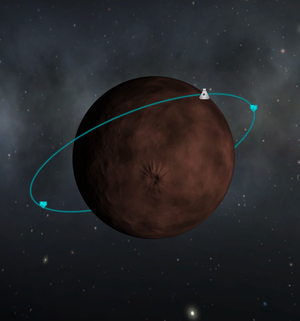Orbit/hu

A "keringési pálya" egy elliptical|elliptikus útvonal az égitest körül[celestial body]. A pálya azon pontját, amely legközelebb áll a körülkeringett égitesthez "periapszis"-nak és a legtávolabbi pontját "apoapszis"-nak nevezzük. Ezek a pontok egyenként jelölve vannak a térkép nézeten mint "Pe" és "Ap".
A Pályát "stabil"-nak nevezzük, ha minden pontja a körülkeringett égitest felszíne és légköre felett van, ezt egyszerűbben értelmezve a periapszis a légkör és az égitest legmagasabb pontja felett van, lévén a periapszis a legalacsonyabb pontja a pályának. Az űrjármű ilyen pályán nem veszíti el a sebességét a légellenállás miatt, és nem ütközik a felszínnek.
Hogy elérjünk egy pályát, az űrjárműnek el kell érnie egy elégséges magasságot és pályasebességet. Az emelkedés közben egy gravitációs forduló segít elérni ezeket a célokat üzemanyag-takarékosan. Utána az alap manőverekkel[basic maeuver] már könnyen változtatható a pálya alakjait.
Tulajdonságok
Minden pályának van néhány alaptulajdonsága amely jellemzi. Eza a lista tartalmaz több olyan értéket, amely a lista más értékeiből is számítható.
Apoapszis és periapszis
- → Lásd még: Apsis on Wikipedia
Az apszisok határozzák meg a pálya legközelebbi és legtávolabbi pontjait. The periapsis is the lowest point of the orbit and is helpful to determine if the orbit is high enough to avoid collisions with the surface or interaction with an atmosphere. The apoapsis is on the other side of the orbit and the furthest point away from the orbited celestial body. The periapsis is not shown if it lies under the surface. There might be confusion about from which point the apsides are measured. In game they are shown from the surface, while for orbital mechanics usually the values from the center of the body are relevant. A craft after the most recent apoapsis and before the periapsis is falling towards the surface while a craft after the most recent periapsis and before the apoapsis is rising.
For parabolic and hyperbolic orbits, there is never a apoapsis shown as it lies outside the sphere of influence. Apoapsides in other spheres of influence are possible. The periapsis of the current trajectory is only shown if it is in the future, and as soon as the craft passes through the periapsis and is rising it vanishes. Like apoapsides, periapsides in other spheres of influence are possible.
In perfect circular orbits it is not possible to determine the apsides. The altitude, which is always the same for the orbit, is used for the apsides if required. They are identical to the semi-major axis when measured from the center. Elliptical orbits have usually both apsides and only no periapsis if it is below the surface. If an orbit is almost circular it is usually treated as perfectly circular where both apsides and the semi-major axis are identical if measured from the body's center.
Sometimes there are special words used for the different bodies. Apokee or apokerb for the apoapsis of an orbit around Kerbin and similar perikee or perikerb for the periapsis around Kerbin.
In Kerbal Space Program the apsides are usually abbreviated to “Ap” and “Pe” which corresponds with the two markers on the orbit. In real world science an uppercase Q is used for apoapsides and a lowercase q for periapsides because variables usually only contain one letter. Using a for the apoapsis is not recommended as it can generate confusion with the semi-major axis which usually uses that variable name.
Notes
External links
- Orbit on Wikipedia
- Apsis on Wikipedia
- Low Earth orbit on Wikipedia